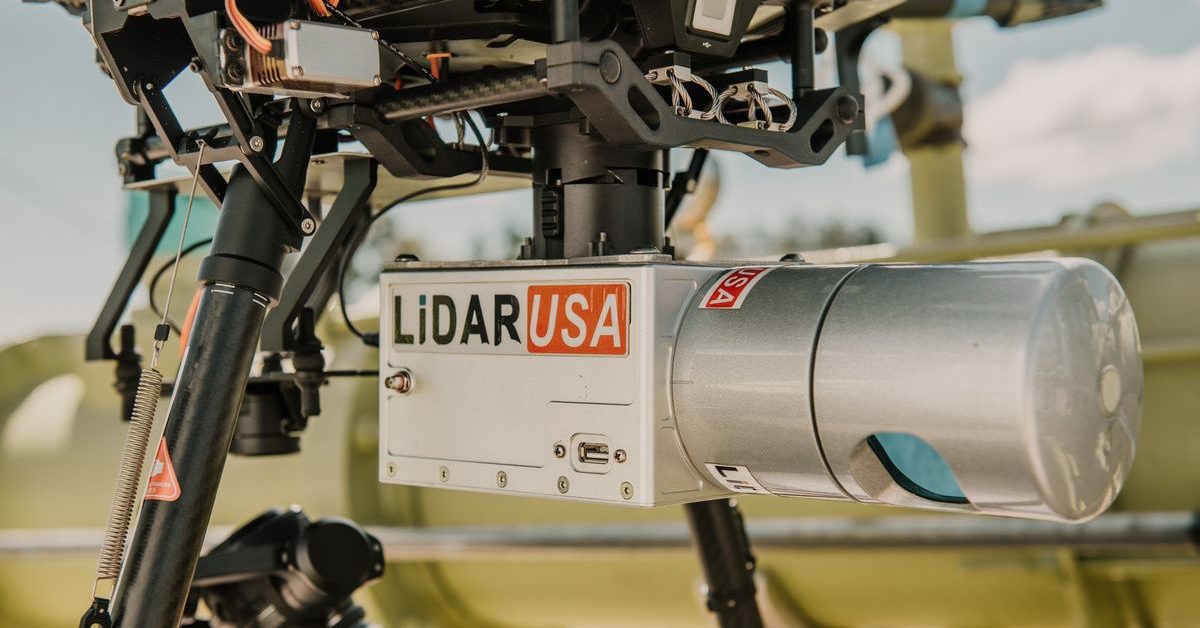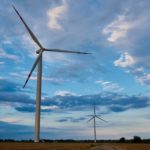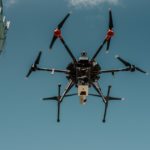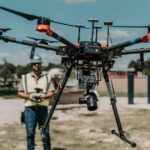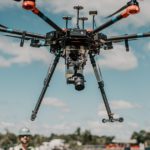Offshore inspections usually come with some challenges. However, drones are able to quickly, accurately, and safely complete offshore inspections, and can be more convenient than in-person inspections. In this article, we’ll look at the uses drones have in offshore inspections, as well as the costs and benefits that come with them.
What is an Offshore Drone Inspection?
Offshore inspections are required in a lot of industries, but gas and oil companies specifically have to complete these inspections routinely to ensure safety and prevent offshore accidents. Completing these inspections can be very challenging, as many structures are very high or over open water. Some can also involve accessing confined spaces that are difficult to get into.
Traditional offshore inspections often involve technicians suspended from ropes or scaffolding. Some parts of these inspections could also be done using cranes, ships or boats, or large aircraft. However, using these methods could be dangerous, expensive, and time-consuming.
Using drones to complete offshore inspections has streamlined the process since drones can access offshore environments easily and fly safely over open water. It’s also easier for them to reach the top of tall structures and maneuver in tight, confined spaces.
Remote pilots fly unmanned drones around and above structures that are set for inspection. Drones are equipped with technology that can gather and process extremely detailed data very quickly, which allows inspectors to watch as the inspections take place via live-streamed video. This data is then stored remotely and can be reviewed by inspection teams from anywhere.
Drones that are equipped with LiDAR sensors can create detailed 3D images of structures that provide a more detailed view than a traditional visual inspection.
What Are Offshore Drone Inspections Used For?
Offshore drone inspections can be used for quite a few things, including the inspections of buildings, checking for oil spills, and squeezing into tight spaces. We’ve detailed some of the most common uses for offshore drone inspections below.
Flare Stacks
Flare stacks are used to burn unwanted gases and waste, which means they can be dangerous. In order to inspect a flare stack without the use of a drone, the stack would need to be shut down. Drones enable inspections to be done while the stacks remain live so that operations aren’t interrupted.
Drones that are fitted with thermal imagers can give inspectors useful data. Thermal imaging can tell inspectors a lot about how a flare stack is functioning by detecting temperature changes. This technology is used to monitor flare stack flames and ignition flames.
Drone cameras capture images of flare stacks from various angles, producing detailed data and images that are difficult or impossible to obtain using other inspection methods. For example, a drone inspection can detect corrosion, loose pieces, damage, and other details that provide inspectors with a complete picture of the stack’s condition.
Offshore Decks and Risers
Getting quality images of decks and risers can also be challenging. To get a good view, cameras must be able to get under the decks. It’s important to perform thorough inspections of these structures because problems like corrosion can cause damage. Drone inspections are an effective and convenient way to make sure inspections are as complete and detailed as possible.
Experienced drone pilots can fly the drones safely beneath the decks to capture detailed images of risers and underdecks. The high-resolution imaging also allows inspectors to spot areas of corrosion easily.
Tankers
Oil tankers are used to safely transport large volumes of fuel. Tanker leaks and spills can be catastrophic for the environment. Spills can have severe negative consequences on human lives, and cost companies huge amounts of money in lost fuel and expensive cleanup efforts.
Tankers can be prone to corrosion because they are in constant contact with oil, gases, and seawater. Inspections are critical to ensure these tankers are in good shape.
Tanker inspections involve setting up scaffolding, working at great heights, and maneuvering in confined spaces. While these inspections can reduce the occurrence of oil spills, they are a major undertaking for any oil and gas company.
According to ConocoPhillips, setup and inspection generally take a full seven days per tank. A drone can perform the same inspection in less than a day. This translates to substantial savings in manpower and overall cost.
Confined Spaces
Many aspects of offshore inspections require working in confined spaces, such as the inside of boilers and fuel tanks. These spaces are often hazardous to work in, especially if gas is present.
Remote pilots can fly drones safely inside confined spaces, capturing data that inspectors can safely view from afar. While there are some challenges, like low lighting and radio signal reflection, technological advances are always improving the way we collect images and data in confined spaces.
Spill Detection
Oil spills are extremely dangerous to workers and the environment. However, detecting an oil spill quickly and accurately by identifying its source can help prevent major disasters. Drones fitted with high-resolution cameras, thermal imagers, LiDAR sensors, and other technology can detect and locate spills so they can be dealt with quickly.
If a spill is detected, a drone can be deployed quickly. It can accurately find the source of the spill so that repairs can be made immediately, preventing as much damage as possible. Drones can also map the boundaries of the oil spill, which comes in handy for monitoring damage and helps make cleanup quick and effective.
Site Selection
Offshore site selection for the placement of energy savers like wind farms is an important piece of energy operations. There has been an uptick in the number of new offshore wind farms in the last several years.
The new site selection process is rigorous. There are many factors that go into site selection, including the ability to connect to the power grid, the amount of wind the area experiences, and environmental risks.
Site selection requires surveying very large areas of open water, which is a difficult and time-consuming task when you’re using traditional methods. Drones are able to perform these checks quickly while capturing critical details. This reduces the cost of labor, equipment, and other resources so projects can begin faster.
LiDAR-equipped drones create detailed 3D maps of large areas, which inspectors can then view remotely. Site selection is critical for successful offshore energy operations and drones help ensure that success.
What Are the Benefits of Offshore Drone Inspections?
There are a variety of benefits of using drones to conduct offshore inspections. Some of these benefits are improved safety, increased accuracy, faster completion times, and saving money.
Improved Safety
Offshore inspections have a history of being difficult and dangerous because inspectors have to use ropes, cranes, and scaffolding to access structures if they don’t use drones. There is a chance of inspectors or equipment falling, both of which can be harmful. Drones can access these structures more easily so inspectors never need to leave the shore, which eliminates the risk of falls.
Most of the time, offshore inspections require inspectors to be close to hazards such as fuel, fumes, and fire. Before the use of drones, operations would need to be suspended before inspectors could come close enough to inspect the structures. Even if operations were halted, there would still be a huge risk of contact with dangerous chemicals and gases, and even tiny errors or misjudgments could result in injury.
By using drones, inspectors don’t need to be anywhere near these hazards. Instead, remote pilots operate drones from a safe distance, and inspectors can review data from shore or an office on the other side of the world.
Increased Accuracy
In the past, offshore inspections were hard to accomplish. Inspectors had to visually inspect structures and were only able to detect damage and malfunctions that were obvious. However, drones equipped with LiDAR and thermal technologies can find problems that can’t be seen with the naked eye.
Drones can fly above, below, around, and inside of structures from multiple angles and their high-resolution cameras capture views that can’t be seen otherwise. Instead of slowly inspecting one section at a time, drones allow inspectors to quickly look over the whole structure, so nothing gets missed, no matter how small.
Using drones to conduct offshore inspections means that anyone can view the data. Anyone on the team can access images and 3D maps, instead of just the person performing the inspection. Data can be looked at as many times as necessary because it’s stored remotely. The convenience and thoroughness of drone inspection can increase the likelihood of minor damage being caught before it creates major problems.
Faster Inspections
Depending on the structure being inspected, offshore safety inspections could take hours, days, or even weeks to complete manually. Drones can perform these same inspections in a fraction of the time, which means companies can save money and make sure their employees are safer.
When companies choose to use drones, there’s no need to transport or set up equipment. The drone performing the inspection is the only equipment they’ll need. Plus, drones travel quickly, which means they can inspect large areas in a shorter amount of time.
Faster inspections will allow repairs to be done quickly, possibly preventing major damage. This also means that operations can begin again with little service interruption. Fast inspections also mean fewer hours of labor are needed, resulting in significant savings in labor costs.
What Does an Offshore Drone Inspection Cost?
Offshore inspections have historically been very expensive, requiring highly trained and experienced workers, heavy equipment, and lots of hours of labor. But offshore inspections via drone can cost as little as $______ per day, which cuts the cost of inspection by up to 80%, on average. Completing offshore inspections using drones cuts costs because drone inspections don’t require the extra equipment, manpower, or time.
The exact cost of an inspection will vary depending on the type of inspection, as well as the location and any special considerations. The Unmanned Aerial Services team at Fenstermaker will help you decide the equipment you’ll need and how much it will cost.
Final Thoughts
Offshore safety inspections are critical to ensure safety and prevent expensive and dangerous incidents. Drones can perform these inspections safely and accurately and can save time and resources. Using drones makes sure that inspectors, offshore workers, the public, and the environment are kept safe.
The benefits of using drones to perform offshore safety inspections are endless. They save time and money, plus the risk of injury to employees is drastically reduced. The next time you need an offshore inspection, consider taking advantage of technology and using a drone to help out.
